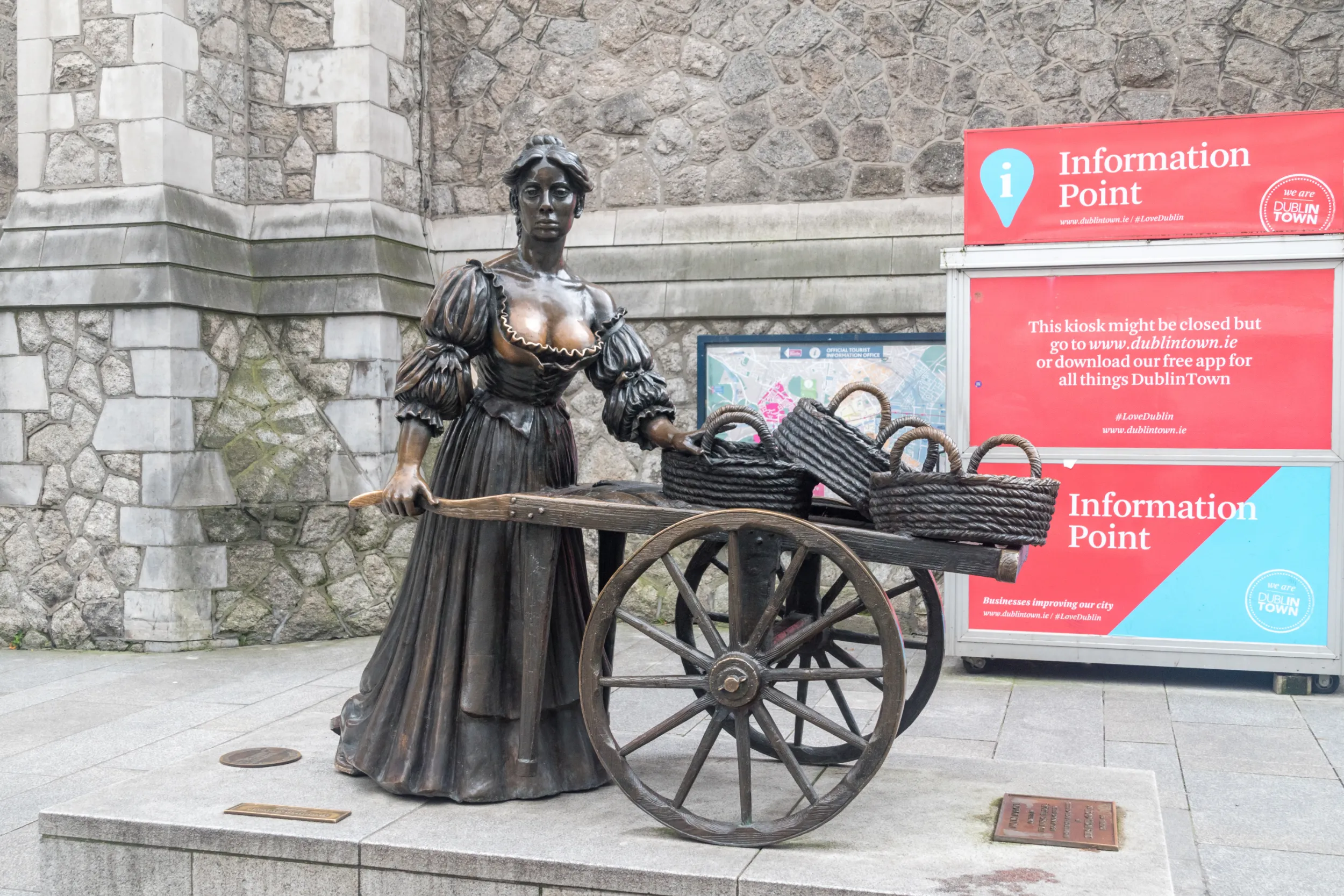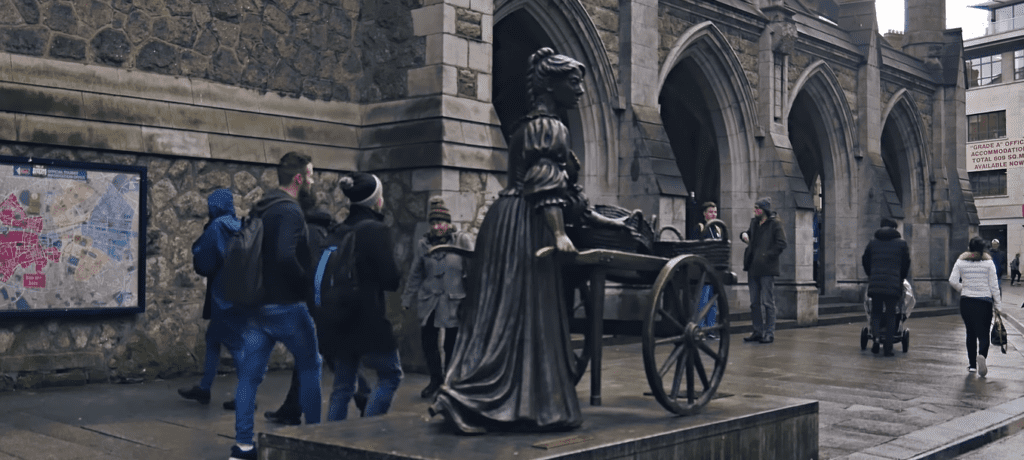Molly Malone Statue – Dublin, Ireland

Updated On: April 06, 2024 by Ciaran Connolly
Nestled amidst the cobblestone streets and bustling atmosphere of Dublin, Ireland, stands a timeless tribute to the city’s rich history and enduring spirit—the Molly Malone Statue. This iconic sculpture, depicting a young woman with a determined expression pushing a wheelbarrow brimming with seafood, is more than just a tourist attraction; it is a symbol deeply woven into Dublin’s cultural identity.
The tale of Molly Malone, immortalized in the beloved Irish folk song “Molly Malone” or “Cockles and Mussels,” transcends generations, captivating the imagination of all who hear it. In this enchanting ballad, Molly is portrayed as a spirited young woman who navigates the bustling streets of 17th-century Dublin, selling seafood by day and engaging in a less reputable trade by night. Though steeped in folklore and legend, her story has become integral to Dublin’s collective memory, evoking a sense of nostalgia and pride among locals and visitors alike.
In 1988, Dublin took a bold step to commemorate this legendary figure by commissioning sculptor Jeanne Rynhart to create a bronze statue in Molly’s likeness. Located on Grafton Street, one of the city’s most iconic thoroughfares, the Molly Malone Statue quickly became a focal point for tourists and a source of inspiration for artists, writers, and musicians.
Beyond its artistic merit, the Molly Malone Statue holds profound symbolism for the people of Dublin. It represents the city’s maritime heritage, harking back to a time when Dublin was a thriving port city teeming with life and commerce. Moreover, Molly’s fictional character embodies the resilience and tenacity of the working-class individuals who shaped Dublin’s history. It serves as a poignant reminder of their contributions to the city’s growth and prosperity.
However, the statue has not been without its controversies and criticisms. Some have questioned the decision to immortalize a fictional character in bronze. In contrast, others have raised concerns about the portrayal of Molly Malone as a scantily clad young woman, arguing that it perpetuates stereotypes and objectifies women. Despite these debates, the Molly Malone Statue continues to hold a special place in the hearts of Dubliners, serving as a beloved symbol of their cultural heritage and identity.
In this article, we delve deeper into the history, symbolism, controversies, and enduring significance of the Molly Malone Statue, exploring how this iconic landmark has come to embody the spirit of Dublin and capture the imagination of all who encounter it. From its humble beginnings as a folk song character to its status as a global emblem of Irish culture, the story of Molly Malone and her enduring legacy offers a fascinating glimpse into Dublin’s past and present.
Table of Contents
The Legend of Molly Malone
The origins of the Molly Malone Statue are intertwined with a famous Irish folk song, “Molly Malone” (also known as “Cockles and Mussels”). The song tells the tale of a fictional young woman named Molly Malone who sold cockles and mussels daily and plied a less reputable trade by night. Legend has it that Molly tragically succumbed to a fever, becoming a ghost that haunts the streets of Dublin.
The song’s lyrics, passed down through generations, immortalize Molly as “the tart with the cart,” a spirited and independent woman who navigated life’s challenges in 17th-century Dublin. While the historical accuracy of Molly Malone’s existence remains uncertain, her legend has become deeply ingrained in Dublin’s cultural heritage.
The Creation of the Statue
The idea to commemorate Molly Malone in statue form first emerged in the mid-20th century, as Dublin sought to celebrate its cultural identity and promote tourism. In 1982, a Dublin-based sculptor named Jeanne Rynhart was commissioned to create a sculpture that would capture the spirit of the iconic figure.
Rynhart’s design envisioned Molly Malone as a young woman pushing a cart filled with seafood—a nod to the lyrics of the folk song. The sculpture was crafted from bronze and unveiled on Grafton Street, one of Dublin’s most famous thoroughfares, on 13 June 1988. Since then, the statue has become a beloved landmark and a symbol of Dublin’s heritage.
Symbolism and Significance

The Molly Malone Statue holds significant cultural and historical importance for the people of Dublin. Beyond its association with the folk song, the statue serves as a reminder of the city’s maritime past and bustling marketplace. In the 17th century, Dublin was a thriving port city, and seafood vendors like Molly Malone played a vital role in the local economy.
Moreover, Molly Malone has come to represent the resilience and spirit of the people of Dublin. Her fictional character embodies the strength and determination of the working-class individuals who laboured tirelessly to make a living in challenging times. Dubliners have embraced Molly through the centuries to symbolise their identity and heritage, ensuring her legacy endures.
Impact on Tourism
The Molly Malone Statue has become an iconic symbol of Dublin and a must-see attraction for visitors to the city. Tourists flock to the statue to snap photos with Molly, learn about her story, and soak in the vibrant atmosphere of Dublin’s streets.
The statue’s central location on Suffolk Street, near Grafton Street and Trinity College, makes it easily accessible to tourists exploring the city centre. Its significance as a cultural landmark is further enhanced by its inclusion in guided tours and promotional materials highlighting Dublin’s historical and cultural attractions.
Controversies and Criticisms
While the Molly Malone Statue is widely celebrated, it has not been without its controversies and criticisms. Some have questioned the historical accuracy of immortalizing a fictional character in statue form, arguing that it detracts from Dublin’s natural history and heritage. Additionally, there have been debates over the portrayal of Molly Malone as a scantily clad young woman, with concerns raised about perpetuating stereotypes and objectifying women.
In recent years, efforts have been made to address these concerns and present a more nuanced interpretation of the statue’s significance. Public discussions and initiatives have focused on contextualizing Molly Malone within the broader narrative of Dublin’s history and acknowledging the contributions of real-life women who shaped the city’s past.
The Molly Malone Statue Today
Despite the controversies surrounding its creation, the Molly Malone Statue remains an enduring symbol of Dublin’s cultural identity. Visitors flock to Grafton Street daily to glimpse the beloved statue and snap photos of the iconic figure. Tourists and locals pay homage to Molly Malone, offering tributes in the form of flowers, coins, and other tokens of appreciation.
In addition to its role as a tourist attraction, the Molly Malone Statue continues to inspire artists, writers, and musicians who draw upon its symbolism in their creative works. The statue has been featured in numerous films, television shows, and literary works, further cementing its place in popular culture.
Attractions Near the Molly Malone Statue
Near the Molly Malone Statue, visitors can discover a plethora of attractions that offer insight into Dublin’s rich history, vibrant culture, and stunning architecture. Here are some notable landmarks and points of interest within walking distance of the iconic statue:
Trinity College Dublin
Just a short stroll from the Molly Malone Statue lies Trinity College, Ireland’s oldest and most prestigious university. Visitors can explore the historic campus, marvel at the architectural splendor of the Old Library, and view the Book of Kells, a lavishly illustrated manuscript dating back to the 9th century.
Grafton Street
Dublin’s premier shopping thoroughfare, Grafton Street, is a bustling hub of activity lined with an array of shops, boutiques, cafes, and street performers. Visitors can immerse themselves in the lively atmosphere, shop for souvenirs, or simply enjoy a leisurely stroll along this iconic street.
Dublin Castle
Steeped in history and grandeur, Dublin Castle is a must-visit attraction located just a short distance from the Molly Malone Statue. Visitors can explore the castle grounds, admire the majestic architecture, and delve into the rich history of this former seat of British rule in Ireland.
St. Stephen’s Green
Escape the hustle and bustle of the city by taking a leisurely stroll through St. Stephen’s Green, a picturesque park located near Grafton Street. With its lush greenery, tranquil ponds, and scenic walking paths, it offers a peaceful retreat from the urban landscape.
National Museum of Ireland – Archaeology
History enthusiasts will delight in a visit to the National Museum of Ireland – Archaeology, which is home to an extensive collection of artifacts spanning Ireland’s rich archaeological heritage. Highlights include the Ardagh Chalice, the Tara Brooch, and the iconic bog bodies.
Temple Bar
Dublin’s cultural quarter, Temple Bar, is a vibrant neighborhood renowned for its lively pubs, eclectic galleries, and vibrant street art. Visitors can soak up the atmosphere, enjoy live music sessions, and explore the myriad of shops, cafes, and restaurants that line its cobbled streets.
Christ Church Cathedral
One of Dublin’s most iconic landmarks, Christ Church Cathedral is a stunning example of medieval architecture and a testament to the city’s religious heritage. Visitors can marvel at its intricate carvings, climb the tower for panoramic views of the city, and explore its crypt, which houses the remains of Dublin’s past residents.
Dublin Spire
Dominating the skyline of O’Connell Street, the Dublin Spire, also known as the Monument of Light, is a striking modern monument that stands as a symbol of Dublin’s regeneration and progress. Visitors can admire its sleek design and towering height, which makes it a prominent landmark in the city center.
From historic landmarks and cultural institutions to vibrant shopping districts and serene parks, the area surrounding the Molly Malone Statue offers a diverse range of attractions that cater to all interests and tastes. Whether you’re a history buff, a shopaholic, or simply looking to soak up the atmosphere of Dublin’s bustling streets, there’s something for everyone to enjoy just steps away from this iconic monument.
Conclusion
The Molly Malone Statue is a testament to Dublin’s rich heritage, folklore, and cultural vibrancy. Despite the passage of time and the city’s evolution, Molly Malone remains an enduring symbol, captivating the hearts and imaginations of all who encounter her. As Dublin continues to grow and change, the statue serves as a reminder of the city’s past and a beacon of its future—a timeless icon beloved by generations.






